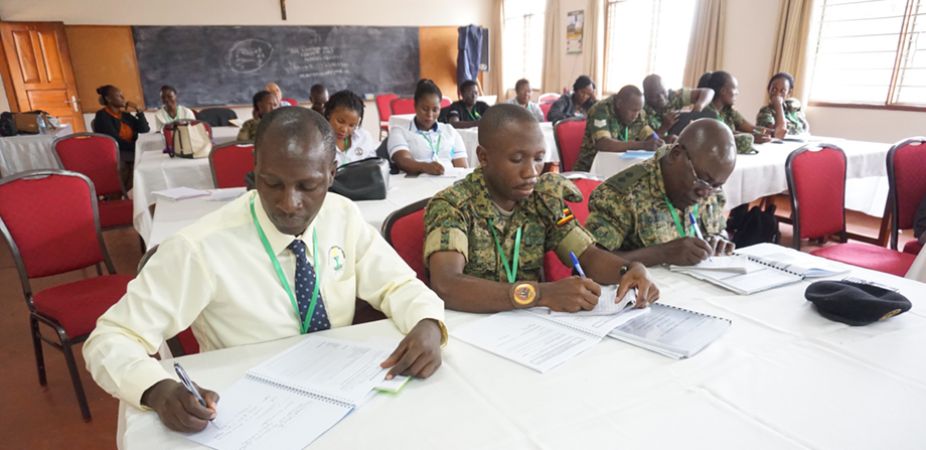
Expanding Training in Uganda
Dr. Deborah Silveria, PhD., licensed Psychologist, LMFT, felt well prepared when she arrived in Kampala, Uganda to facilitate an EMDR II training in November of 2018. The foundation for success had been laid in the extensive planning and budgeting for the session by Carol Martin, Executive Director, Trauma Recovery|Humanitarian Assistance Programs (TR|HAP) and invaluable insights and advice from the EMDR I facilitators, Leslie Brown, MA, LPC and Janet Wright, LCSW.
Arriving a few days early for the session she was co-facilitating with TR|HAP facilitator Dr. Sushma Mehrotra, PhD., she hurdled local logistical obstacles to get materials and facilities ready for the upcoming 3-day training. What she wasn’t prepared for was the vibrant African energy and warmth radiating from the smiles of the Ugandans she met, and reverberating in the air. Silveria came to share EMDR knowledge. She says she left with a deep appreciation for the challenges her Ugandan mental health colleagues manage, respect for their determination to become EMDR certified, and gratitude for the many new professional friendships formed.
Mission and Challenges
The goal of the Uganda EMDR training effort is to bring trauma healing to underserved communities across Uganda through a local community of certified EMDR therapists and consultants. The impetus for the Uganda training was a Catholic charity working locally, who contacted Carol Martin early in 2018 about EMDR instruction. However, the recent mission follows much earlier efforts led by TR|HAP facilitators, Merrill Powers and Rosemary Masters.
A diverse group of mental health professionals gathered for the training at the Jesuit Seminary, including Uganda People’s Defense Force (UPDF) military counselors, private sector clinicians from the Amani Institute Uganda, treating substance abuse and other disorders, and members of EMDR Uganda in private practice and teaching at the University. These clinicians deal with very different specialty populations and trauma-related mental health issues each day. Approximately 23 clinicians participated in the EMDR II session, comprised of 3 days of EMDR training and a day of case consultations.
Mundane challenges like horrific Kampala traffic, spotty internet service and British English made session attendance and communication difficult. However, adapting the training to the various clinician groups with sensitivity to their specialized populations was a more complex facilitator task. In addition, the facilitators had to navigate and balance political correctness, opposing power and gender biases and differing agency concerns with their delivery, while avoiding cultural taboos. Perhaps the greatest challenge was helping participants work collaboratively with each other on cases and learn to trust each other well enough to transcend individual agency affiliations and interests. It is hoped that fostering on-going collaboration within the participant group can lead to referrals, local consultation and a trauma-healing team view over time. Since completing the training, Silveria and Mehrota, along with EMDR I facilitators Brown and Wright, conduct two consultation sessions every month with four participants aspiring to become certified EMDR consultants.
Faith in Healing Hurt, Creating World Peace
Deb Silveria has been treating children and adults suffering from complex trauma with EMDR since completing training in 1995. Once clinical director for a Level 14 group foster home in southern California, she knows that these populations are often the most underserved, frequently treated by the least experienced clinicians. Today in private practice, Deb focuses on “kids and cops” she says; that is, children and public safety personnel. Her own recovery from earthquake-related trauma and the healing she has seen case after case fuels her passion for EMDR.
Widely travelled, she has worked in the Far East and India as a missionary, and administered post- earthquake relief and recovery in Haiti, living in a MASH tent. Though suffused with clinical and international aid expertise and her love for cultural discovery, Silveria prepared for her first international EMDR training assignment. In addition to guidance from the EMDR I team, she read widely about Uganda, its history and treating culturally based trauma. She also consulted a Ugandan MD friend for trip advice, and built up her immune system with nutrition and exercise. She feels a “team” spirit and preparation combined with Dr. Mehrotra’s experience and knowledge of international training guaranteed their session success, though they had never met before.
Dr. Silveria believes Bessei VanderKolk’s saying, “hurt people hurt people” and has faith that healing trauma and curing hurt people may ultimately lead to world peace. Her advice to those interested in international training efforts is:
- Become a TR|HAP trainer, this organization and their support is the best in the world,
- Be adaptive and flexible, things change in an instant,
- Prepare intellectually and physically,
- Expect to come away enriched emotionally and spiritually by the people you will meet.